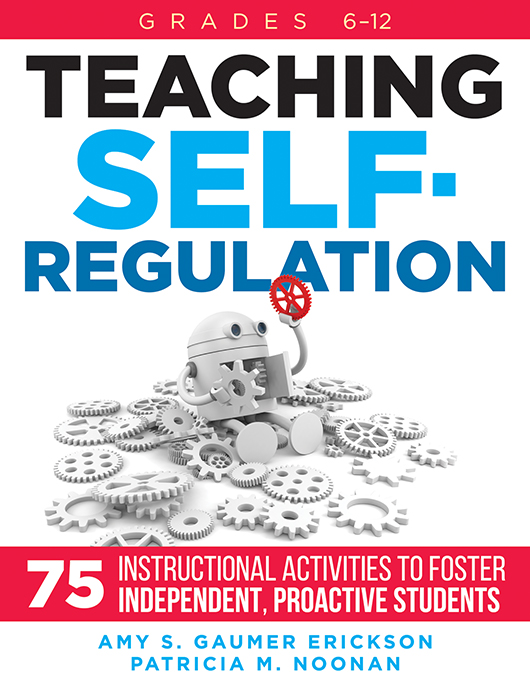Free Reproducibles
Teaching Self-Regulation
Seventy-Five Instructional Activities to Foster Independent, Proactive Students, Grades 6–12
Self-regulation fuels students to become socially and emotionally engaged, lifelong learners. With this timely resource you’ll gain 75 instructional activities to teach self-regulation in any secondary classroom. Ample teacher-tested tools and templates are also included to help you create authentic learning experiences and deliver effective feedback.
Benefits
- Explore the four components for successful self-regulation—(1) plan, (2) monitor, (3) adjust, and (4) reflect.
- Develop students’ planning abilities for both personal and academic goals.
- Guide students in adjusting plans when faced with obstacles.
- Study real-life scenarios of how to shift from regulating for students to coaching students to self-regulate.
- Review testimonials from teachers and students who have seen and experienced the positive results of self-regulation practices.
Table of Contents
Chapter 1: Understanding Self-Regulation
Chapter 2: Making a Plan
Chapter 3: Monitoring Your Plan and Progress
Chapter 4: Adjusting Your Plan
Chapter 5: Reflecting on Your Efforts and Outcomes
Chapter 6: Putting It All Together
Chapter 7: Measuring Growth in Self-Regulation
Epilogue: Next Steps
Appendix A: Situational Judgment Assessment
Appendix B: Self-Regulation Questionnaire and Knowledge Test
Appendix C: Scenarios
Appendix D: Student Templates
PRINTABLE REPRODUCIBLES
Introduction
Chapter 1
- Figure 1.1: Competency Wheel
- Figure 1.2: Self-Regulation Poster
- Figure 1.3: Check for Understanding—Definition and Purpose
- Figure 1.4: Is This Self-Regulation?
- Figure 1.5: Connecting Outcomes and Behaviors
- Figure 1.6: My Self-Regulation Assessment Results
- Figure 1.7: Evaluating My Efforts
- Understanding Self-Regulation
Chapter 2
- Figure 2.1: Feeling Words Wheel
- Figure 2.2: Reflecting on Academic Planning
- Figure 2.3: Common Elements of Self-Regulation Plans
- Figure 2.4: Check for Understanding—Planning Elements
- Figure 2.5: Olivia’s Homework Plan Example
- Figure 2.6: Homework Prompts
- Figure 2.7: Guiding Questions for Emotional Regulation
- Figure 2.8: Feedback Prompts for Planning
- Making a Plan
Chapter 3
- Figure 3.2: Monitoring Methods
- Figure 3.3: Check for Understanding—Monitoring Progress and Actions
- Figure 3.4: Determining Options for Monitoring Progress and Actions
- Figure 3.5: Levi’s Public Speaking Plan
- Figure 3.6: Feedback Prompts for Monitoring
- Figure 3.7: Effort and Learning Chart
- Figure 3.8: Homework Log
- Monitoring Your Plan and Progress
Chapter 4
- Figure 4.3: Check for Understanding—Planning, Monitoring, and Adjusting
- Figure 4.4: Barriers and Strategies
- Figure 4.5: Writing If–Then Statements
- Figure 4.6: Determining Outcomes From Choices
- Figure 4.7: Managing Distractions in Your Short-Term Plan
- Adjusting Your Plan
Chapter 5
- Figure 5.1: Reflection Questions
- Figure 5.2: Check for Understanding—Reflecting
- Reflecting on Your Efforts and Outcomes
Chapter 6
- Figure 6.1: Benefits of Self-Regulation
- Figure 6.2: Check for Understanding—Self-Regulation Components
- Figure 6.3: Finding Missing Components—Example Scenario
- Figure 6.4: Finding Missing Components
- Figure 6.5: My Self-Regulation Posttest Results
- Putting It All Together
Chapter 7
- Figure 7.2: Self-Regulation Performance-Based Reflection
- Figure 7.3: Self-Regulation Performance-Based Observation
- Measuring Growth in Self-Regulation
Epilogue
- Figure E.1: Instructional Criteria
- Figure E.2: Teacher and Student Roles in Self-Regulation Instruction
- Figure E.3: Competency Framework Practice Profile for Teachers
Appendix A
Appendix B
Appendix C
- Activities 19, 58, and 69
- Activities 20, 34, and 46
- Activities 21 and 35
- Activities 22, 36, and 59
- Activity 60
- Activity 70
Appendix D

